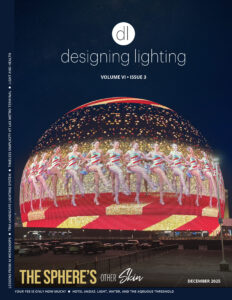When Andrea took the stage at Light Middle East, I expected an update on IALD as she serves as its President. I was wrong. Instead she share her best practices. In today’s environment, it is easy to tell if a presentation is well received–everyone is snapping pictures of the slides. Andrea hit it out of the park as some people never put their camera down.
In a candid speech, Andrea Hartranft, Principal AHLD shared her valuable insights and experiences about managing a design firm. Her talk, filled with personal anecdotes and practical advice, offered a realistic view of the challenges and triumphs of running a business in the creative field.
The Essence of Teamwork and Leadership
Hartranft emphasized the importance of teamwork and collaboration in the design world, stating, “It’s your design, but there’s no room, at least not on my team, for divas.” She advocates for a team-oriented approach, eschewing drama and ego-driven behavior.
Hartranft also highlighted the necessity of adaptability, risk-taking, and effective time management in the industry. She believes in hiring individuals who bring different strengths to the table, often those smarter than herself. “Why would I hire another one of me?” she quipped, underlining the value of diverse skills in a thriving business.
Management and Delegation: The Backbone of Success
A significant part of her talk revolved around the art of management and the importance of delegation. “As your firm grows, you do want to manage, you want to delegate because you’re managing risk,” Hartranft explained. She described the reality of owning a firm as far from the “sexy and romantic” image many might have. Her day-to-day responsibilities often include mundane tasks like handling bills, managing finances, and even taking out the trash.
The Dreams and Realities of Ownership
Hartranft candidly discussed the financial aspects of running a firm. “The reality is at least in the beginning, your firm will continue to grow and make money. But when the money’s not there, guess who’s not getting paid?” she asked, pointing out the personal financial risks involved. She emphasized that while higher income is a potential, it should not be the primary motivation, especially in a niche like lighting design.
Communication and Work-Life Balance
Hartranft shared her insights on the varied communication preferences within her team and how adapting to these can smooth out operational kinks. She also touched upon the concept of work-life balance, humorously noting, “I have the flexibility to work all the time.”
Partnerships and Growth
Reflecting on the evolution of her firm, Hartranft stressed the importance of choosing partners wisely. “Think very, very carefully about taking on partners,” she advised, sharing how partnerships impacted her firm’s dynamics and finances. She also discussed the significance of planning for the future, including having an exit strategy for the business. She also emphasized how well her decision to add partners has paid off.
Financial and Legal Acumen
A key piece of advice from Hartranft was the importance of financial literacy and having a solid support team, including a lawyer, a bookkeeper, and an accountant. “Clients that don’t pay aren’t clients,” she firmly stated, underscoring the need to be aware of and manage the firm’s finances diligently.
Communications
Andrea took her team for a retreat and brought in an expert to discuss communications. She explained that people in her office that are over age 50 typically prefer to be communicated with through email, a phone call or a text. Contrast that to people under 40 and they strongly prefer slack over a phone call or text. She went on to say that her over 50 group works fine with Slack, but they might check it at the end of the day, whereas they will typically respond to an email instantly if the are in front of their email.
Final Thoughts
Andrea’s speech was a treasure trove of practical wisdom for anyone looking to start or manage a design firm. Her honest reflections and straightforward advice provided a clear-eyed look at the realities of business ownership in the creative industry. As she concluded, “Be honest with yourself about what you can and can’t do, and ultimately, it’s the best thing I ever did. No regrets.”




